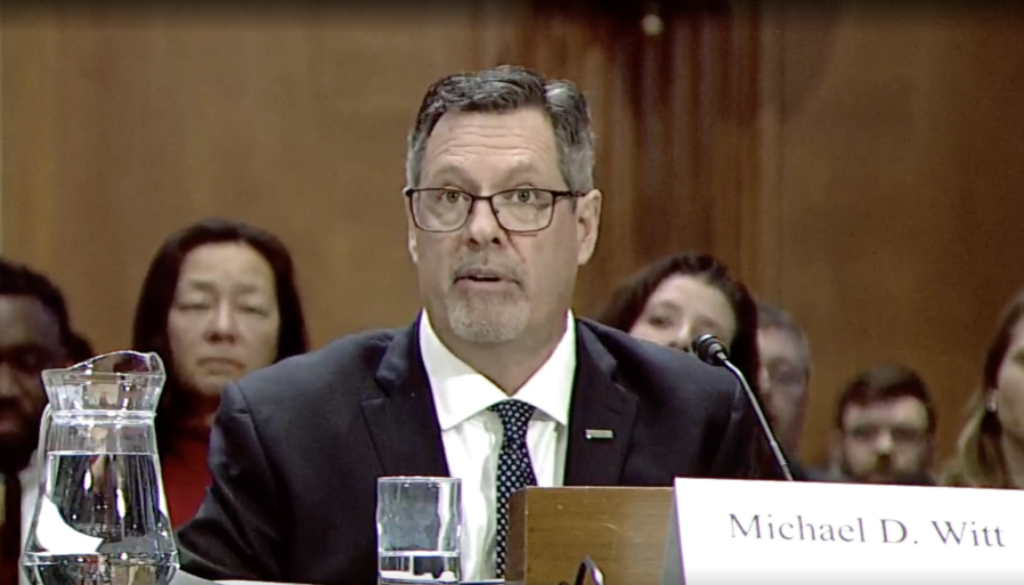Warnings of a “wave of lawsuits” as PFAS exemption debated
Representatives of US water and waste systems told US lawmakers this week that hundreds of such operations across the nation could face unintended and overwhelming liabilities unless they are exempted from a proposal that would designate two types of per- and polyfluoroalkyl substances (PFAS) as hazardous substances.
The rule proposed by the Environmental Protection Agency (EPA) sets up “multiple avenues to drag innocent parties into extremely costly and complex litigation,” Michael Witt, a lawyer speaking on behalf of a coalition of water groups, told members of the US Senate Committee on Environment and Public Works in a hearing Wednesday.
Witt was one of multiple witnesses to address the committee on the hotly contested issue of how the government should address widespread PFAS environmental contamination. The EPA said in 2022 that it was preparing to designate perfluorooctanoic acid (PFOA) and perfluorooctanesulfonic acid (PFOS) as hazardous substances under the Comprehensive Environmental Response, Compensation, and Liability Act (CERCLA) because they present “a substantial danger to human health or welfare and the environment.”
Such a designation allows the government to order responsible parties to clean up the environmental contamination and bear the costs of mitigation. The “polluter pays’ model is a core principle of CERCLA.
The debate now underway is about whether to provide an exemption from liability for “passive receivers” of PFAS – entities that don’t make or use PFAS but wind up with the chemicals in their water, land and waste. The EPA has said it won’t assign liability to passive receivers, but Witt and others speaking at the hearing said there is still concern that such entities could become embroiled in lawsuits over chemicals they never used or produced.
Speaking at the hearing, Sen. Shelley Capito, a Republican from West Virginia, said more than 250 entities have sent letters of concern to the committee.
“Without Congressional action, a wave of lawsuits could potentially raise taxes and utility rates on millions of Americans,” Capito said at the hearing. “This result flips the ‘polluter pays’ principle on its head, turning it into a ‘consumer pays’ model.”
But environmental advocates argue that an exemption for water utilities and others is unnecessary and would eliminate incentives those entities have to properly treat and contain contamination. They also worry giving some sectors an exemption creates a slippery slope that could ultimately help polluters evade liability.
“Instead of taking action to reduce [PFAS] releases, industry leaders are now urging you to create more loopholes,” Scott Faber, senior vice president of government affairs for the Environmental Working Group (EWG), testified to the senate committee. Water utilities and waste managers are already addressing many other hazardous substances, he added.
Most importantly, efforts should focus on halting PFAS pollution at its source, he said.
“I think we’d all agree we shouldn’t be making this problem bigger,” said Faber. “There are likely more than 30,000 companies that are discharging PFAS into the air and water right now, and if we were to take steps to limit those discharges, that would be less PFAS entering the drinking water systems and landfills.”
Protecting innocent parties
PFAS, which do not break down naturally, are found in countless consumer products, including nonstick cookware, makeup, and carpet, and have been detected in drinking water systems across the US.
In December, a group of global cancer experts designated PFOA as carcinogenic and PFOS as “possibly” carcinogenic to humans. The EPA says that evidence from laboratory animal and human epidemiology studies indicate that exposure to either can cause cancer, reproductive and developmental and cardiovascular problems and potentially harm the liver, kidney, and immune system.
These so-called “forever chemicals” have left utilities with a pricy problem. A single pound of PFAS costs between $50 and $1,000 but costs between $2.7 million and $18 million to remove and destroy from wastewater, according to the Minnesota Pollution Control Agency.
The EPA released a strategic roadmap to address PFAS pollution in 2021 and last year proposed legally enforceable levels for six PFAS chemicals in drinking water, including PFOA and PFOS, which are expected to be finalized soon.
As part of its plan, the EPA has sought to reassure passive receivers, stating that, if the designation is finalized, it will target PFAS manufacturers and facilities that have released large amounts of the chemicals into the environment, not water utilities, farmers, airports, or local fire departments where the PFAS contaminants reside.
Still, those assurances won’t carry the “force of law,” Witt told the committee. “It’s not enough,” he said.
Witt, who serves as general counsel for the Passaic Valley Sewerage Commission in New Jersey, said utilities might be dragged into lawsuits despite the EPA’s intentions.
“CERCLA provides even the most culpable parties with multiple avenues to drag innocent parties into extremely costly and complex litigation, and there’s little EPA can do to stop it,” he said.
Witt said his own utility is still involved in a 28-year-long Superfund case over pollution from a chemical it had nothing to do with – an “extremely toxic” byproduct of Agent Orange, the herbicide infamously used in the Vietnam War.
The company Diamond Alkali manufactured Agent Orange on the banks of the Passaic River in the ‘50s and ‘60s, leaving behind pollution that Witt said will cost billions of dollars to remediate. Diamond Alkali has exploited CERCLA to drag the utility and 40 other public entities through decades of litigation, said Witt.
“When we talk about enforcement discretion and the protections you might get, they’re really quite ephemeral,” said Witt. “The way that we get protection under this is to get exemption. It’s not a loophole.”
In other testimony Wednesday, environmental lawyer Robert Fox told committee members that without an exemption, landfills may refuse to take in waste with elevated PFAS levels. This would delay PFAS cleanups at other sites and disrupt the nation’s municipal waste infrastructure, according to Fox, who represented the National Waste and Recycling Association & Solid Waste Association of North America.
“The solid waste sector is not looking for relief where the groundwater at landfills has been impacted by these PFAS compounds due to landfill operations,” said Fox. “Rather, we are seeking a narrowly tailored exemption from CERCLA liability arising from permitted leachate discharges.”
Farmers, who sometimes spread sewage sludge on their fields as a fertilizer, would also not be protected under CERCLA despite an existing exemption for the “normal application of fertilizer,” said Fox, because no standards currently exist under the Clean Water Act for PFAS in fertilizer.
Approaching the PFAS problem
Those concerned with the forthcoming CERCLA designations are, in part, concerned because the EPA has finalized regulatory standards for PFAS under other federal environmental statutes. Listing PFAS chemicals under CERCLA first is “unprecedented,” said Fox.
In February, the EPA announced a proposal, which is not yet finalized, to update the definition of hazardous waste in the Resource Conservation and Recovery Act (RCRA) to include PFAS, a move designed to strengthen protections for communities located near the 1,740 permitted hazardous waste facilities across the country.
It would be best to first address PFAS under RCRA, which is implemented by the US EPA and the states, before addressing the chemicals under CERCLA, which is implemented by multiple federal agencies, including the Department of Defense, James Kenney, secretary of the New Mexico Department of the Environment, said at the hearing,
“Under CERCLA, implementation of those rules allows the Department of Defense as one entity to police itself,” he added. “That has not worked.”
Migrating plumes of PFAS in groundwater from DOD operations threaten New Mexico’s agricultural industry, said Kenney. The state has already paid $850,000 to help a dairy farmer dispose of cows he was forced to euthanize after they were contaminated with PFAS from a nearby DOD base, while the agency has not paid for remediation.




